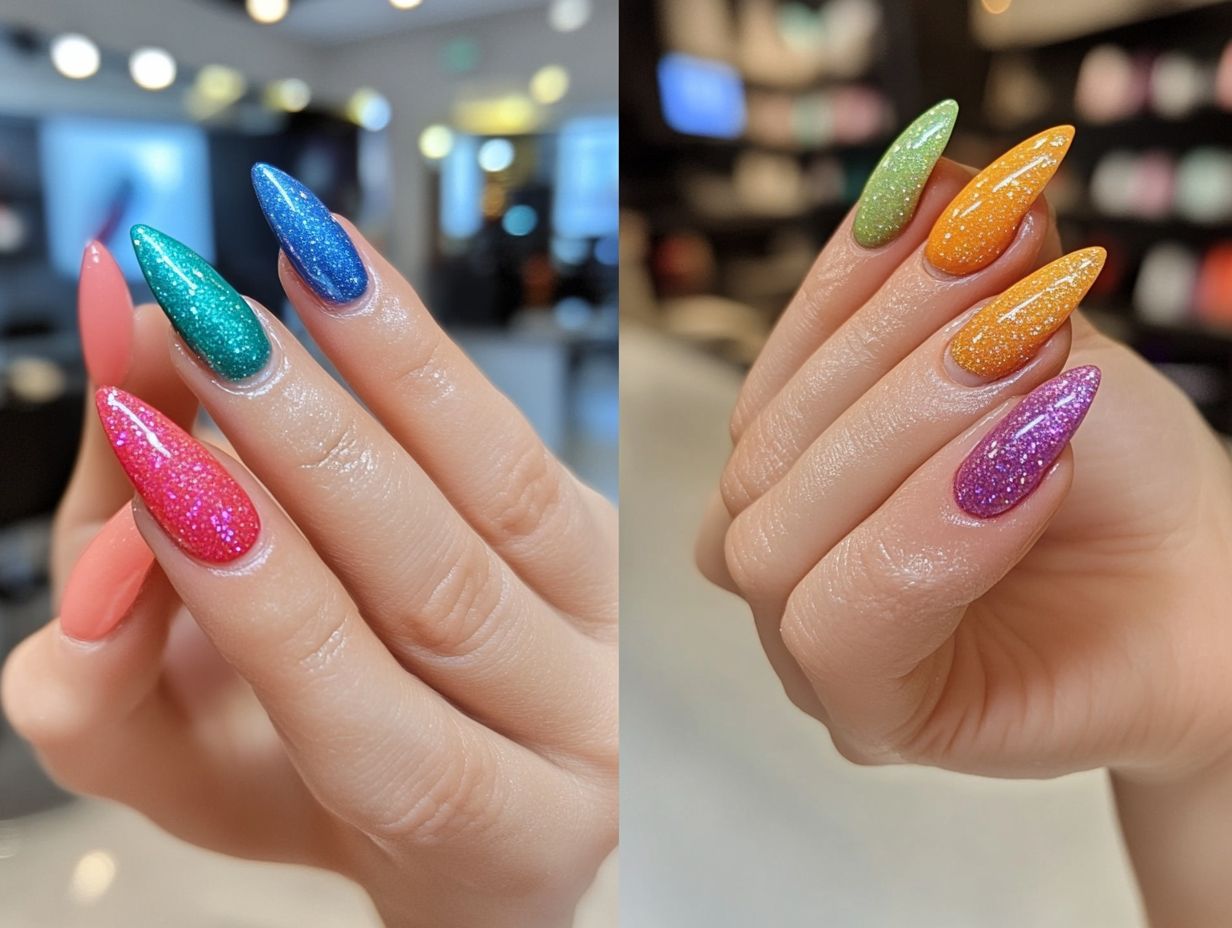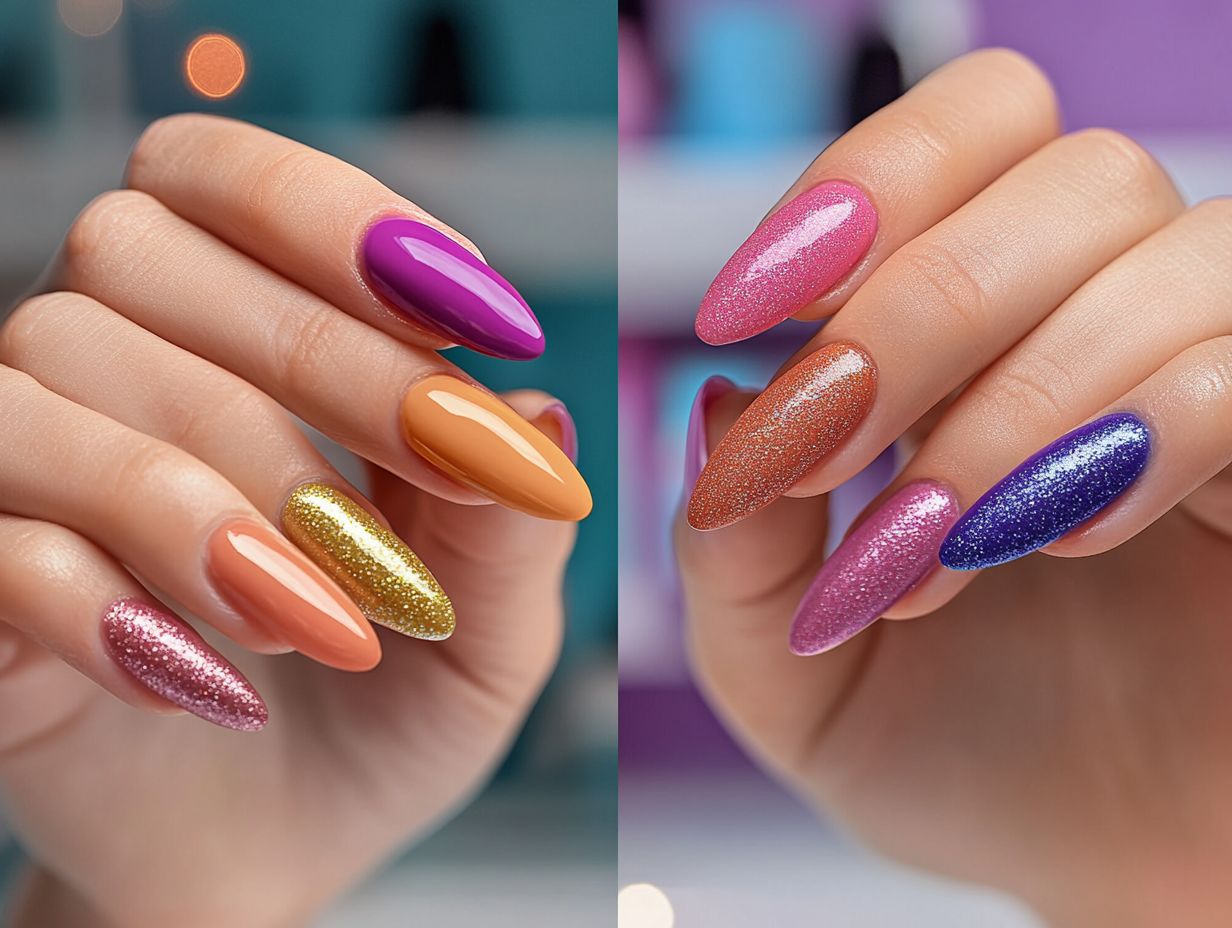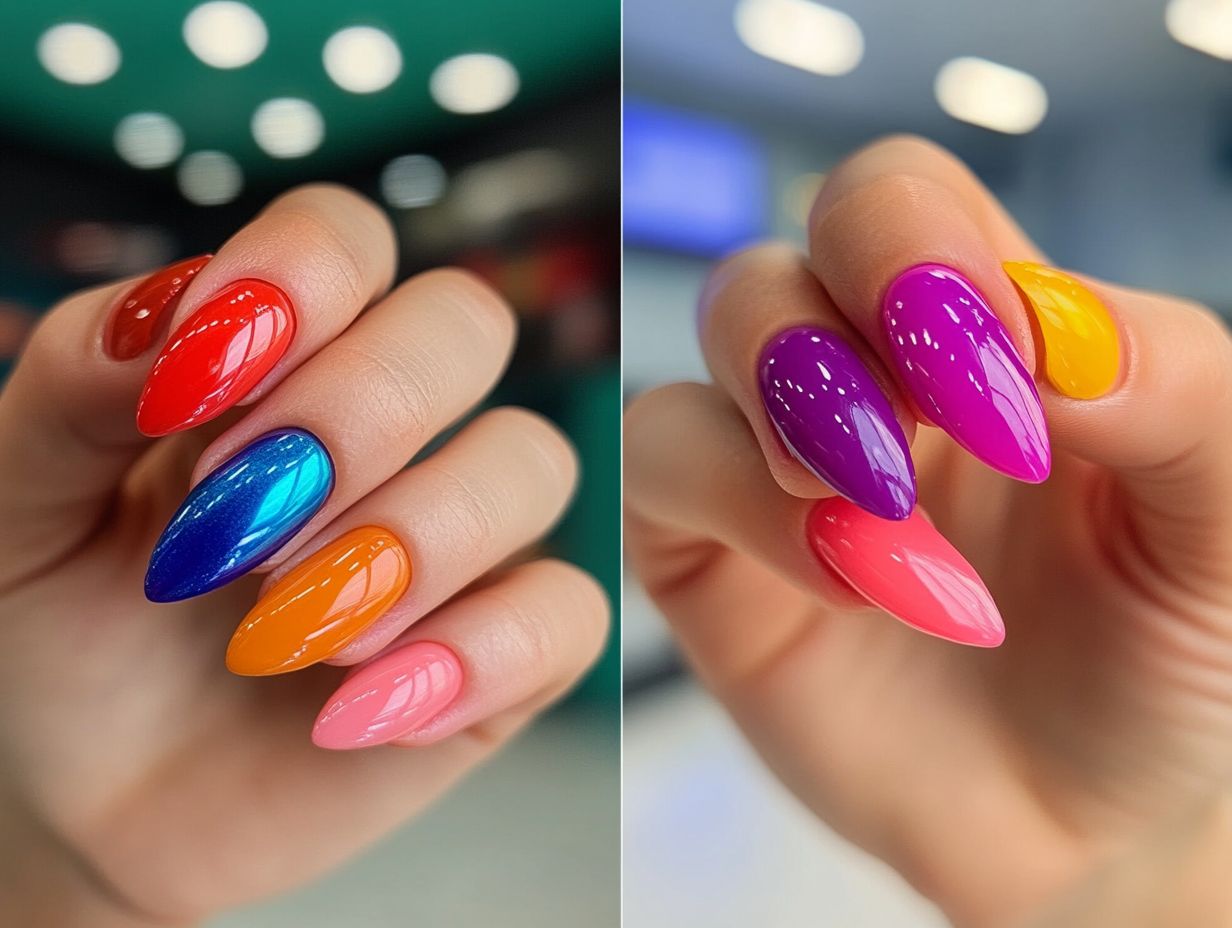In the world of nail care, gel and acrylic nails have gained immense popularity, each offering unique benefits and styles.
Whether you’re looking for something long-lasting, customizable, or chic, choosing between these two options can be daunting.
This piece breaks down the key differences in durability, appearance, and maintenance, while also considering lifestyle factors and nail health.
Additionally, it weighs the pros and cons of each type and provides essential tips for care and removal.
Dive in to discover which nail option might be the perfect fit for you!
Table of Contents
Key Takeaways:

- Gel nails are more durable and long-lasting compared to acrylic nails, making them a better option for those with an active lifestyle.
- Acrylic nails offer more customization options, allowing for various shapes and designs, while gel nails have a more natural and glossy appearance.
- The cost and maintenance of gel and acrylic nails differ, with gel nails being more expensive but requiring less frequent maintenance compared to acrylic nails.
What are Gel and Acrylic Nails?
Gel and acrylic nails are two widely recognized forms of artificial nail enhancements that not only enhance aesthetic appeal but also contribute to the health and strength of natural nails. These manicure techniques are prevalent in the beauty industry, with nail professionals emphasizing their unique characteristics, advantages, and uses.
Gel nails typically deliver a glossy finish and flexibility, while acrylic nails offer a sturdy structure, making them an ideal choice for individuals prioritizing durability.
Gaining an understanding of the distinctions between these options can assist in selecting the most suitable solution for attaining beautiful, resilient nails.
Comparison of Gel and Acrylic Nails
The comparison between gel and acrylic nails typically revolves around their durability, aesthetic appeal, and cost, making it crucial for nail enthusiasts to comprehend the advantages and disadvantages of each option.
While both types yield an attractive finish, their application methods, maintenance demands, and longevity vary considerably. Gel nails are recognized for their glossy finish and lighter weight, whereas acrylic nails provide a more durable and long-lasting solution.
Evaluating factors such as nail structure and individual lifestyle can aid in making an informed decision.
Durability and Longevity

Durability and longevity are critical considerations when selecting between gel and acrylic nails, as these factors can significantly influence one’s nail maintenance routine and overall satisfaction with the manicure. Gel nails generally provide flexibility and a high-gloss finish, while acrylic nails are recognized for their strength and resistance to chipping. The lifespan of each type of nail enhancement varies based on several factors, including application techniques and the care administered during the filling and removal processes.
An individual’s lifestyle also plays a significant role in the duration of these enhancements. For example, frequent exposure to water, harsh chemicals, or engaging in physically demanding activities can accelerate wear and tear.
Typically, gel nails last approximately two to three weeks, whereas acrylic nails can endure for up to four weeks, contingent upon proper maintenance. To preserve their appearance and durability, it is essential to engage in regular moisturizing and follow gentle nail care practices, such as minimizing the use of acetone and ensuring that hands and nails remain well-hydrated.
Additionally, scheduling regular salon appointments for fills or touch-ups can greatly contribute to prolonging the lifespan of either type of nail enhancement.
Appearance and Customization
In terms of appearance and customization, both gel and acrylic nails provide an extensive array of options for nail art enthusiasts, facilitating limitless creativity and self-expression. Gel nails can achieve a glossy finish available in various gel polish colors, while acrylic nails can be crafted into intricate designs and shapes using acrylic powders and liquid monomers. For more insights, check out Gel vs. Acrylic Nails: Which Is Better?.
This versatility in nail design allows individuals to select styles that not only align with their personal aesthetic but also reflect the latest trends in the nail industry.
Nail technicians play a pivotal role in transforming these fundamental options into exquisite works of art, employing advanced techniques such as ombre, marbling, and hand-painted designs. The selection of embellishments, including rhinestones, foils, and stamping plates, further expands the creative possibilities, resulting in each set of nails being a distinctive statement.
With seasonal trends frequently evolving, ranging from minimalist styles to bold graphic prints, the adaptability of both acrylic and gel nails ensures that individuals can remain fashionable within the dynamic realm of nail art while simultaneously expressing their individuality.
Cost and Maintenance
Cost and maintenance are critical factors to consider when choosing between gel and acrylic nails, as these can vary significantly based on individual preferences and lifestyle.
Gel nails typically necessitate a fresh application every two to three weeks, with costs generally ranging from $40 to $70 per visit, depending on the salon’s location and expertise. Conversely, acrylic nails may require refill appointments every three to four weeks and tend to be somewhat more economical, averaging around $30 to $50.
It is essential to emphasize that both types of nails require professional removal to safeguard optimal nail health; attempting to remove them at home can result in damage, weakening the natural nail bed and causing long-term complications. Prioritizing professional nail care and safety is crucial to ensuring that the integrity of one’s natural nails remains intact while benefiting from the aesthetic advantages of these popular enhancements.
Factors to Consider When Choosing Between Gel and Acrylic Nails

Several factors must be considered when selecting between gel and acrylic nails, as each option has distinct characteristics that may influence nail health and the overall experience.
It is important to understand one’s nail sensitivity and lifestyle habits to make an informed decision that aligns with personal preferences and requirements.
Consulting with a qualified nail technician can offer valuable insights into which option may be most appropriate for an individual’s needs.
Nail Health and Sensitivity
Nail health and sensitivity are critical factors to consider when comparing gel and acrylic nails, as improper application or removal can result in damage to natural nails. Individuals with sensitive skin or allergies should thoroughly assess the products utilized in both gel and acrylic applications, as well as the techniques employed by nail technicians.
Adhering to proper nail care routines is essential to prevent adverse reactions and to promote overall nail health.
Those who suffer from conditions such as onychomycosis or psoriasis may be particularly vulnerable to irritation from certain nail enhancements. For these individuals, selecting hypoallergenic products can significantly mitigate the risk of allergic reactions.
Regular moisturizing and the use of cuticle oil can further strengthen the nails, maintaining their health between visits. Choosing experienced technicians who are knowledgeable about these sensitivities can also make a considerable difference.
It is imperative to prioritize quality over cost to ensure that only safe, reputable materials are utilized. By being mindful of these considerations, individuals can enjoy their preferred nail enhancements while still safeguarding their natural nail health.
Lifestyle and Activities
The choice between gel and acrylic nails is significantly influenced by an individual’s lifestyle and daily activities, as each type presents distinct levels of durability and maintenance requirements. Factors such as occupation, hobbies, and the frequency of nail maintenance should be carefully considered to ensure a selection that aligns with one’s way of life.
For example, individuals engaged in manual labor or occupations that necessitate frequent handwashing may find gel nails more susceptible to chipping. In contrast, acrylic nails may offer better resilience under such conditions, though they can experience lifting if not applied correctly.
Additionally, those whose personal activities include crafts or sports should evaluate how these pursuits might affect the durability of their chosen nail type. Regular maintenance is essential; individuals who can commit to follow-up appointments may find both options manageable, whereas a demanding schedule may favor gel nails due to their extended wear.
Implementing effective nail care practices, such as wearing gloves during household tasks, can substantially enhance the longevity of either nail option.
Pros and Cons of Gel and Acrylic Nails

Understanding the advantages and disadvantages of gel and acrylic nails is essential for making an informed decision that aligns with one’s aesthetic objectives and lifestyle preferences.
Gel nails typically offer a more natural appearance and flexibility, whereas acrylic nails are recognized for their strength and durability. By carefully evaluating the distinct characteristics of each option, individuals can select the alternative that best fulfills their requirements.
Benefits and Drawbacks of Each Type
The benefits and drawbacks of gel and acrylic nails are essential considerations for individuals seeking to identify the option that best aligns with their personal preferences, lifestyle, and nail health objectives.
For example, individuals with a busy lifestyle may prefer the durability of acrylic nails, as their strength enables them to withstand daily wear and tear without chipping easily. However, they should be prepared for the maintenance that accompanies this choice. Conversely, those who prioritize a more natural appearance might choose gel nails, valuing their semi-permanent shine and the flexibility they provide.
It is also crucial to consider the time commitment involved; the frequent salon visits required for gel nail maintenance can accumulate over time. Ultimately, carefully weighing these factors will give the power to individuals to select the nail solution that best complements their daily activities and personal style.
Caring for Gel and Acrylic Nails
Caring for gel and acrylic nails is essential for maintaining their aesthetic appeal and ensuring the health of natural nails. This process requires specific maintenance practices and proper removal techniques.
While both types of nails necessitate regular upkeep, the methods and products employed can differ considerably. Familiarity with best practices for nail care, including moisturizing and the application of nail remedies, can significantly enhance the longevity and appearance of professionally manicured nails.
Tips for Maintaining and Removing Nails
Maintaining and removing both gel and acrylic nails effectively can significantly enhance the overall health of natural nails while prolonging the longevity of the manicure. Regular maintenance is essential for both types of nails and often necessitates the expertise of a qualified nail technician to ensure that professional removal methods are employed to prevent damage.
Techniques such as acetone soaks may prove beneficial; however, understanding the correct procedures is crucial for successful nail removal.
To further promote nail health, it is imperative to utilize high-quality products specifically designed for gel and acrylic applications. The application of a strengthening base coat prior to the manicure can provide protection for natural nails against potential damage.
Additionally, regular moisturizing with cuticle oil is vital for keeping the surrounding skin hydrated and healthy, thereby reducing the risk of hangnails and peeling. After the removal process, investing in a nourishing treatment or a nail-strengthening serum will assist in restoring any lost moisture and fortifying the nail bed, ensuring that the nails remain resilient and vibrant long after the manicure has faded. For those considering nail enhancements, check out Gel vs. Acrylic Nails: Which Is Better? to understand the pros and cons.


